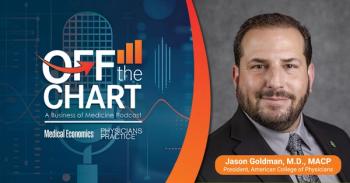
Lead, follow or get out of the way
Innovative medical practices thrive by embracing change, prioritizing patient care and learning from setbacks to enhance success and satisfaction.
Successful practices do not follow others; rather, they make their own paths and follow their own pathways and agendas. When doctors hear about a new treatment or technology, some are early adopters and will embrace anything new and exciting. In contrast, others are followers and wait until all the bugs have been worked out before getting on board. This blog will discuss what early adopters do to implement innovative and exciting practices.
Those who pave new roads and create new paths find the connections between what others have done and what works in their practices. Dr. Christian Chaussy, a urologist in Munich, Germany, noted pitting on the surface of an aircraft as it approached the sound barrier—a unique occurrence caused by the shock wave created in front of a drop of moisture. This finding, coupled with the close collaboration among academic centers and his development laboratories at the University of Munich, led to the invention of extracorporeal shock wave lithotripsy. He made the connection between the pitting noted on airplane wings and the harnessing of shock waves, focusing them on kidney stones. This connection led to the nonsurgical removal of kidney stones, which is now considered the standard treatment worldwide. To date, millions of people worldwide have been successfully treated using Chaussy's breakthrough discovery.
Accept obstacles and roadblocks
Thomas Edison tried nearly 10,000 materials before finding one that worked to create the light bulb. Edison said, "I have not failed 10,000 times. I have successfully found 10,000 ways that will not work." How many projects have you launched that didn't work initially, so you gave up on them? Numerous practices have embarked upon a project or venture only to find it was daunting and unsuccessful. For example, practices have adopted electronic medical records (EMR) systems only to find that productivity in the practice ground to a halt. More than a few practices have abandoned their entire EMR program, wasting significant amounts of time and money. Successful practices have found ways to work around the loss of productivity and ultimately made Electronic Medical Records (EMRs) work effectively in their practices. So, you need to decide . . . are you an Edison, a Chaussy or a capitulator?
Develop a "Plan B"
John Steinbeck said, "The best-laid plans of mice and men often go awry." Not every plan or idea will bear fruit. Many doctors and practices have tried to outsource their billing, only to find disastrous results. In these unfortunate cases, their next plan is to bring billing back in-house and cancel the billing service. (This can also happen in a reverse scenario where the practice must turn to outsourcing as their backup plan because their staff is unqualified to manage an in-house billing program.) Either way, successful practices wisely try new ventures while monitoring results and responses. If the project falls short of projections, it is reasonable to abandon the ineffective plan that is producing negative results and move on to the next best plan.
Focus on providing optimum patient care and financial success will follow
Rules are made for a reason and should be followed. Breaking them can lead to problems, fines, and even incarceration. However, in certain instances, it makes sense for some rules to be bent or broken if it proves to be in the best interest of your patients.
For example, A doctor prescribes a drug that they feel is the best for a patient's condition. After learning that the insurance company (trying to play doctor) recommends a generic drug that is less effective and has more adverse effects because it does not carry the more expensive drug on its formulary, this gives the doctor cause for concern for their patient. The doctor can bend the rules by informing the patient about the potential adverse effects. The doctor can also request that the patient describe any personally experienced adverse effects so that a report can be filed with the insurance company, compelling it to cover the more expensive, more effective medication. Sitting back and doing nothing may be easier, but it may not be in the best interest of the patient. This process will take a few minutes of staff time; however, it ensures that the patient receives the quality medication they deserve. The rule is being bent only with the patient's best interest in mind. I don't believe anyone will arrest or fine you for practicing patient-first healthcare.
Put patient before profits
When Steve Jobs was working on the iMac, he told his team, "Don't worry about price; just specify the computer's abilities. Focus on making the product great, and the profits will follow.
This same concept applies to any medical practice. Focus on providing optimum patient care, and the financial success will follow. Ensuring that patients have a positive experience every time they interact with your practice is crucial for increasing patient satisfaction and enhancing your online reputation.
Yes, you can judge a book by its cover, and make no mistake, patients judge your practice within only four seconds of walking through the front door. What is it that they see? What is their first impression of your staff? What do they see when they use the patient restroom? Did they have to wait long to obtain an appointment? How long were they placed on hold before speaking to a receptionist?
You've heard the expression, "Put yourself in someone else's shoes," and you will allow yourself to feel the experience something from that person's point of view. Making changes to please your patients need not always revolve around the dollar. There are things you can do that only require a small effort on your part but make a big difference in how your patient views (and talks about) your practice.
For example, if you need to refer your patient to another physician for specialized attention, encourage staff to do the preliminary work and make the call and appointment for the patient. Consider that older patients may have difficulty reading small fonts (12pt. or less) on an appointment card. Staffers can flip the card over and write in big letters on the back. Are some patients overly nervous during an injection? Your medical assistant can stand beside them, talk to them, hold their hand, and help divert their attention. I call this verbal anesthesia. Involve your staff in coming up with new ideas; in fact, reward them for their idea contributions.
While surveying patients and conducting focus groups to identify their needs and wants are very beneficial, many offices are afraid to do so because they don't want to see the results.
Conversely, others want to know what their patients want so they can be more accommodating. If you fall into the latter group of informed practices, make sure that when you ask for patients' opinions, you also make a point of listening to what they say and then follow up on their suggestions.
In addition to listening to your patients, ask yourself, "Would you go to a physician like you?" For example, would you wait three or more weeks for an appointment? Would you wait for an hour after your designated appointment to be seen by your doctor? Would you wait for weeks or a month to receive a report on your CT scan, which was ordered to differentiate a cyst from a tumor, when the result was a benign lesion? Tapping into what your patients are experiencing will help you stay attuned to the pulse of your practice. If the care you are extending to your patients is not acceptable to you, then very likely it is unacceptable to them.
Recognize opportunities
Every practice has opportunities that can be used to their advantage. Look at what similar practices are doing and strive to be different. Try to stand out in the crowd. For example, if your patients are mostly employed and work from 9 to 5, consider offering early morning, late afternoon, and Saturday morning appointments. If your patients are uninsured, you can eliminate the associated administrative costs and offer a reduced fee for those who pay cash for their services. If you can convince insurance companies that performing a procedure in your office as opposed to the hospital will reduce costs, they may see the financial advantage of that and allow you to offer your patient the more convenient option. If you perform a minimally invasive procedure that reduces the length of hospital stay, reduces the cost of care, and can get your patients back to gainful employment quicker than other procedures, this will give you a distinct advantage over other doctors who offer a standard procedure that is more costly and has a longer recovery time.
Celebrate successes
It is necessary to acknowledge successes, even if they are small. As Michael LeBoeuf, PhD, says in his book The Greatest Management Principle in the World (Putnam, 1985), "You get what you reward." Please make every effort to let your team know that you appreciate its efforts. Ensure that your staff understands their actions and behavior play a crucial role in ensuring patients have a positive experience. Kenneth H. Blanchard, PhD, and Spencer Johnson, MD, authors of The One Minute Manager (William Morrow, 2003), take that sentiment a step further, saying, "When we focus on what people are doing right, they do more things right." Likewise, when we reward good behavior, we encourage the repetition of good behavior.
Make the change
It doesn't matter if you consider yourself an innovative leader, one that jumps in ahead of the curve, or if you stay just behind it and wait until the waters have been tested. Making the decision to accept change for your practice in pursuit of a successful outcome is a step forward. When moving forward, you should:
- Have an open mind. Hear the facts and consider all possibilities before automatically rejecting an idea. Allow the idea time to develop and prove its effectiveness.
- Seek direct communication. Form or be part of a focus group where you can ask questions and share concerns that will impact your judgment.
- Make an informed decision. Listen and learn. Use whatever methods are available (articles, Webinars, videos, social media, podcasts, etc.) to help understand the pros and cons of an issue.
- Take the leap at your own pace! In the words of a wise Chinese proverb: "Be not afraid of going slowly; be afraid of standing still."
Bottom Line: Doctors and practices need to think outside the box and consider unconventional techniques to market and develop their practices. Practices that continue to do what they have been doing for decades are going to get left behind. Please consider adopting a few of these action steps to reinvent and reconfigure the way you attract and retain patients in your practice.
Newsletter
Optimize your practice with the Physicians Practice newsletter, offering management pearls, leadership tips, and business strategies tailored for practice administrators and physicians of any specialty.










